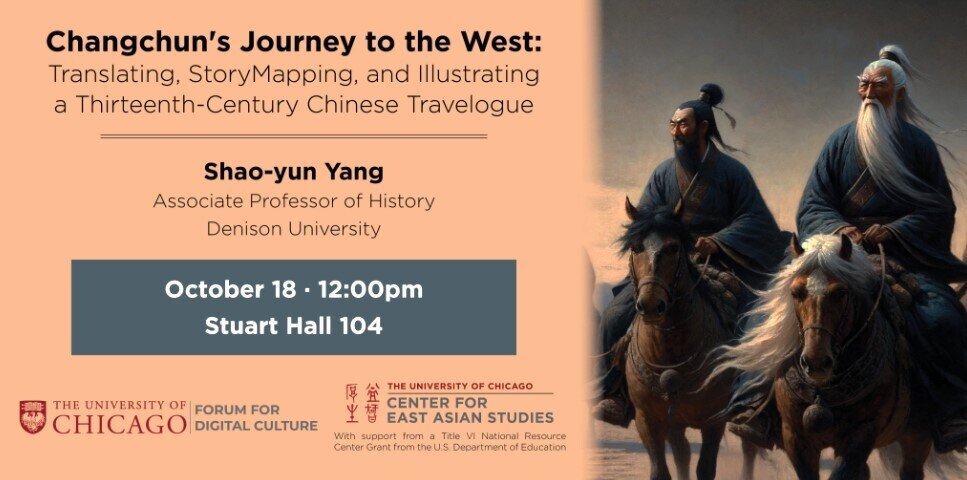Shao-yun Yang

Shao-yun Yang (b. Singapore) is an Associate Professor of East Asian history at Denison University, USA, with his research including ethnocultural identities, foreign relations, and cross-cultural interactions in medieval or “Middle Period” China (broadly defined as 200‑1600 CE).
With a B.A. and M.A. from the National University of Singapore, and a Ph.D. from the University of California, Berkeley, USA, he had extensively published on these subjects — often with digital imagery and maps -, and authored in 2020 (with ongoing updates) a new English translation of the Zhufan zhi 諸蕃志 (1225), a classic Chinese text dealing with the “Southern countries”, including Chenla (Cambodia).
Publications
- Making Sense of Messianism: Buddhist Political Ideology in the Mahayana Rebellion and the Moonlight Child Incident of Early Sixth-Century China, graduation thesis, National University of Singapore, 2005.
- Becoming Zhongguo, Becoming Han: Tracing and Reconceptualizing Ethnicity in Ancient North China, 770 BC — AD 581, MD thesis, National University of Singapore, 2007.
- ““What Do Barbarians Know of Gratitude?” — The Stereotype of Barbarian Perfidy and Its Uses in Tang Foreign Policy Rhetoric”, Tang Studies 31, Dec 2013.
- “Connected Worlds”, conference, Institute of East Asian Studies, UC Berkeley, 2013 [with Benjamin A. Saltzman, Grant Parker, and Shao-yun Yang].
- Reinventing the Barbarian: Rhetorical and Philosophical Uses of the Yi-Di in Mid-Imperial China, 600‑1300, PhD UC Berkeley, Spring 2014.
- “Fan and Han: The Origins and Uses of a Conceptual Dichotomy in Mid-Imperial China, ca. 500‑1200”, in
Francesca Fiaschetti and Julia Schneider eds., Political Strategies of Identity-building in Non-Han Empires in China, 2014. - “The Politics of Omenology”, in Michael Nylan and Griet Vankeerberghen eds., Chang’an 26 BCE: An Augustan Age in China. University of Washington Press, Jan 2015.
- “ ‘Stubbornly Chinese?’ Clothing Styles and the Question of Tang Loyalism in Ninth-Century Dunhuang’, International Journal of Eurasian Studies, Dec 2016.
- ““Their Lands are Peripheral and Their Qi is Blocked Up”: The Uses of Environmental Determinism in Han and Tang Chinese Interpretations of the “Barbarians””, in Rebecca Futo Kennedy and Molly Jones-Lewis, The Routledge Handbook of Identity and the Environment in the Classical and Medieval Worlds, Jan 2016.
- “Letting the Troops Loose: Pillage, Massacres, and Enslavement in Early Tang Warfare,” Journal of Chinese Military History, Jun 2017.
- “Ge Chengyong, “Lighting Lamps to Pray for Blessings While ‘Western’ Music Plays — New Knowledge on the Art of the High Tang Buddhist ‘Eulogy to a Stone Lamp Stand’ in the Xi’an Forest of Steles”, translation of 葛承雍, 《燃灯祈福胡伎乐 — — 西安碑林藏盛唐佛教“燃灯石台赞”艺术新知》, Chinese Cultural Relics, 2017.
- Featured review of BuYun Chen, Empire of Style: Silk and Fashion in Tang China (2019), China Review International, 2019.
- “Shi Xiaozhang’s Spirit Road Stele and the Rhetorical “Barbarization” of Late Tang Hebei”, Tang Studies, 2018.
- Ten maps of the fall of the Eastern Han and the rise of the Three Kingdoms (189−220), revised 2018.
- Maps of the An Lushan Rebellion and its consequences (755−765), revised 2018.
- Supplementary maps for the article “ ‘Stubbornly Chinese?’ Clothing Styles and the Question of Tang Loyalism in Ninth-Century Dunhuang”, revised 2018.
- Supplementary maps for the article “Shi Xiaozhang’s Spirit Road Stele and the Rhetorical ‘Barbarization’ of Late Tang Hebei”, nd.
- Maps of the Jurchen invasion (1126−1140), revised 2018.
- The Way of the Barbarians: Redrawing Ethnic Boundaries in Tang and Song China. University of Washington Press, 2019.
- Race and Censorship in the Siku quanshu Project, slides and talk delivered (via Zoom), Stanford CMEMS, October 2020.
- “Ancient Chinese History in Limericks”, updated April 2020.
- A Chinese Gazetteer of Foreign Lands: A New Translation of Part 1 of Zhao Rukuo’s Zhufan zhi 諸蕃志 (1225), first published June 2020.
- “New Evidence for Song Huizong’s Ban on the Word ‘Han’ ”, research notes, Jan 2021.
- Review of Randolph B. Ford, Rome, China, and the Barbarians: Ethnographic Traditions and the Transformation of Empires, The Journal of Asian Studies, 2021.
- “Ko Ch’a-lao or Xu Chailao: A Mythical Ming Chinese Governor of Luzon”, or. June 9, 2020; revised April 12, 2022.
- Tang “Cosmopolitanism”: Toward a Critical and Global Approach, talk at University of Chicago, May 19, 2022 (video).
- Rethinking Ethnicity and Race in Imperial China, slides presentation and text for a presentation delivered at the plenary session of the American Oriental Society annual meeting, March 20, 2022.
- “Unauthorized Exchanges: Restrictions on Foreign Trade and Intermarriage in the Tang and Northern Song Empires”, T’oung Pao, 2022.
- Pei Xing, “The Kunlun Slave”, translated and illustrated, nd.
- Section on Puduan (Butuan), Song huiyao jigao, transl., nd.
- Journeys to the West: Kitan and Jurchen Travelers in Thirteenth-Century Central Asia, Esri Story Map, nd.
- Twenty maps of the Period of Division, 221 – 589 CE, new 2023 edition.
- Frontiers of the Tang and Song empires, digital map project, nd.
- Li Zhichang’s Daoist Master Changchun’s Journey to the West: To the Court of Chinggis Qan and Back, transl. by Ruth Dunnell, Stephen West and Shao-yun Yang, The Hsu-Tang Library of Classical Chinese Literature, 2023.
- “Early Tang China and the World, 618 – 750 CE,” in Cambridge Elements in the Global Middle Ages, 2023.
- “Late Tang China and the World, 750 – 907 CE,” in Cambridge Elements in the Global Middle Ages, 2023.
- “The Song-Jurchen Conflict in Chinese Intellectual History”, in War and Collective Identities in the Middle Ages: East, West, and Beyond, 2023.
Unpublished essays
- “The nomen Romanum and the Mandate of Heaven: Barbarian Rule and the Idea of Empire in Ostrogothic Italy and Later Zhao North China”, revised seminar paper at UC Berkeley, 2007.
- “The Semantic Context of Word Play with the Label Hu 胡” in “Anecdotes About the Tang”, seminar at UC Berkeley, 2009.
- “Facing West to Worship Heaven: ‘Confucianizing’ Representations of Islam in Yuan and Ming Literati Writings”, revised version of a conference paper presented (virtually) at the AAS-in-Asia, Taipei, June 2015.

